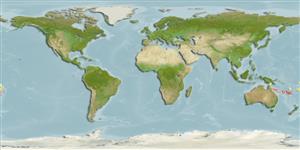Classification / Names
Nomi Comuni | Sinonimi | Catalog of Fishes(Genere, Specie) | ITIS | CoL | WoRMS | Cloffa
>
Pleuronectiformes (Flatfishes) >
Samaridae (Crested flounders)
Etymology: spinea: Named for its caudal peduncle spines, a character found only in this species and Samaris chesterfieldensis..
Environment: milieu / climate zone / depth range / distribution range
Ecologia
marino; distribuzione batimetrica 44 - 88 m (Ref. 83388). Tropical
Distribuzione
Stati | Aree FAO | Ecosystems | Presenze | Point map | Introduzioni | Faunafri
Western Pacific: New Caledonia, Bellona Plateau, Fairway Ridge and Chesterfield Plateau.
Size / Peso / Age
Maturity: Lm ? range ? - ? cm
Max length : 5.3 cm SL maschio/sesso non determinato; (Ref. 83388)
Short description
Morfologia | Morfometria
Raggi dorsali molli (totale): 60-72; Raggi anali molli: 46 - 54. This species is characterized by the following: caudal peduncle with 2-5 spines along both dorsal and ventral margins; caudal fin rays bifurcated except upper- and lowermost 2 simple rays; comparatively deep body, depth 2.41-2.78 in SL (Ref. 83388).
Life cycle and mating behavior
Maturità | Riproduzione | Deposizione | Uova | Fecundity | Larve
Mihara, E. and K. Amaoka, 2004. Pleuronectiform fishes from New Caledonian waters. Five species of the samarid genera Plagiopsetta and Samaris (Samaridae). in Marshall, B. & Richer de Forges, B. (eds), Tropical Deep-Sea Benthos, volume 23. Mémoires du Muséum national d’Histoire naturelle 191:611-635. (Ref. 83388)
IUCN Red List Status (Ref. 130435)
Threat to humans
Harmless
Human uses
Informazioni ulteriori
Nomi ComuniSinonimiMetabolismoPredatoriEcotossicologiaRiproduzioneMaturitàDeposizioneSpawning aggregationFecundityUovaEgg development
Age/SizeAccrescimentoLength-weightLength-lengthLength-frequenciesMorfometriaMorfologiaLarveDinamica popolazioni larvaliReclutamentoAbbondanzaBRUVS
BibliografiaAcquacolturaProfilo di acquacolturaVarietàGeneticaElectrophoresesEreditarietàMalattieElaborazioneNutrientsMass conversion
CollaboratoriImmaginiStamps, Coins Misc.SuoniCiguateraVelocitàModalità di nuotoArea branchialeOtolithsCervelliVista
Strumenti
Special reports
Download XML
Fonti Internet
Estimates based on models
Preferred temperature (Ref.
123201): 23.8 - 25.3, mean 24.2 °C (based on 6 cells).
Phylogenetic diversity index (Ref.
82804): PD
50 = 0.5312 [Uniqueness, from 0.5 = low to 2.0 = high].
Bayesian length-weight: a=0.01622 (0.00604 - 0.04358), b=2.94 (2.71 - 3.17), in cm total length, based on LWR estimates for this (Sub)family-body shape (Ref.
93245).
Trophic level (Ref.
69278): 3.5 ±0.4 se; based on size and trophs of closest relatives
Fishing Vulnerability (Ref.
59153): Low vulnerability (10 of 100).
